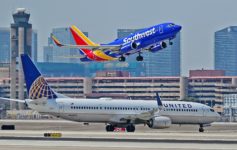United Airlines is rolling out “ConnectionSaver” technology across the board after successful trials in Denver and Chicago. The new tool has great potential.
Gate agents often will not hold a flight because of the unknown ripple effects of doing so. Say you hold a flight for five minutes to allow for a group of delayed connecting passengers to board. That five-minute delay may cause a 20-minute delay in takeoff due to a missed takeoff slot. Suddenly, instead several passengers faced missed connections and the next flight on that aircraft also faces delay.
But what if gate agents could know with high certainty if holding the fight would negatively implicate take-off time and connecting passengers onboard? What if gate agents knew that six extra minutes was okay, but not eight? That technology is now here with United’s ConnectionSaver tool.
What is ConnectionSaver?
United explains the multi-faceted nature of its ConnectionSaver technology:
ConnectionSaver is powered by new technology that automatically identifies departing flights that can be held for connecting customers, while ensuring those who have already boarded the aircraft arrive at their destination on time. ConnectionSaver also sends personalized text messages to every connecting customer (who has opted in to receive notifications) with clear directions to the gate for their connecting flight and information about how long the walk will take.
United’s ConnectionSaver technology automatically scans flights for customers who are making tight connections to determine if the connecting flight can be held without inconveniencing other customers. The ConnectionSaver tool takes into account factors such as the time it will take for late connecting customers to travel gate-to-gate as well as the impact the hold may have on other flights and customers.
United created a couple of videos to explain the new technology, which I think do a great job of doing so:
For the seasoned traveler, United wants to soothe your anxiety over missing your onward connection so a straggling family can make a flight. Toby Enqvist, United’s Chief Customer Officer stated:
ConnectionSaver only works if it allows us to care for as many customers as possible – without inconveniencing others – and that’s exactly what this technology has shown it can do. We’re determined to capitalize on as many opportunities as possible to better serve and care for our customers and that’s part of what sets United apart from our competitors.
United makes clear that most flights will NOT be held for delayed passengers.
CONCLUSION
Tools like ConnectionSaver show the upside to modern technology. Guiding passengers on their mobile phones via the United app to their next gate and carefully balancing the ripple effect of even a small delay are now possible. But many things sound nice in theory. Now we have to wait and see if this technology actually works in practice.





Maybe they should do away with the ridiculously short minimum connection time. Like seriously, 50 minutes to get off the plane and change terminals (including going through immigration and security again)?
Whole heartedly agree, I often make bookings without checking connection times and get the sweats when I find out I’ve locked into a 30 min. connection. I’ve missed too many flights and lost too many bags due to this. However, hopefully this means that they’ll no longer lock us out of connections by mere minutes while the plane is still at the gate.
Missed “takeoff slots” is a common misnomer in the industry. The only there becomes a “slot” is when there is a Traffic Management Program in effect which ATC meters traffic due to weather or other restrictions like runway closures. When you call clearance delivery, they’ll give you an EDCT also known as a “wheels up” time. If you miss, you get a new time.
I like how UA really plays this up. They should always be doing this. The reason why people are missing connections is because the MCT is to tight and their operation isn’t as good as they think.
American will do this, umm, never. And they need it the most. Dallas is a hot mess in this with sold connections at 30-40 minutes that are virtually impossible to make. Add in the AA gate agents being militant about closing the doors 10 minutes before departure and vanishing down the jetway with no agent left at the counter. Can’t tell you how many times I was there 8-10 minutes before published departure due to a late inbound and could do nothing but stand and look at a closed door with 20 other people.
So I wonder about United. Will this be a decision based on actual departure time or the 10 minute door closing rule. If actual departure time I think this is an amazing tool.
Good for them. This is a good idea, at least in theory, and they deserve kudos for thinking and being innovative (I mean beyond making the entire travel experience shittier by mindlessly cutting costs anytime they can, and charging for things that once were part of the price of a ticket). So good for them for trying this, credit where credit is due.
So when UA’s on-time performance tanks, I can see them blaming this new software.
Over fifty years of flying, I have been “saved” only once where a plane was held for me and that was with Alaska Airlines. We were a late night arrival into Seattle with a connection on the last plane of the night to Portland. Alaska had a golf cart waiting for us at the gate and took us to the waiting plane, where we were the last to board. We were astonished, and Alaska Airlines forever holds a special place in our hearts because of it. They went way beyond normal for us, and we were grateful. If United can provide some saves like that here and there, it will spread a lot of very needed goodwill.
This is nothing new. Seeing late arrivals has always been available. I was a gate agent for 21 years, and know how the game is played. It’s good advertising in my opinion. There is plenty of padded flight time to adjust for holding a flight for a few minutes. No big deal.
Didn’t United just roll out a bonus program encouraging on-time departures? That bonus program seems counterproductive to this system.
While I like the idea, as others have noted, the real problem is how the airlines (not just UA) shoehorn passengers onto impossibly short connections these days. A 45-minute connection at DEN or IAH leaves you basically no margin for error, given that you have at most 10 minutes to get from your plane to the connecting gate before boarding starts. (Trust me – with a 50-minute connection at SLC last month and a seat in the very back, even with a connecting gate directly across our arrival gate, we didn’t make it until 5 minutes after scheduled boarding. Luckily the connecting flight was delayed.) And as JBM and others note, given Scott Kirby’s obsession with D0, I have a hard time believing GAs will really feel empowered to hold flights even a few minutes.